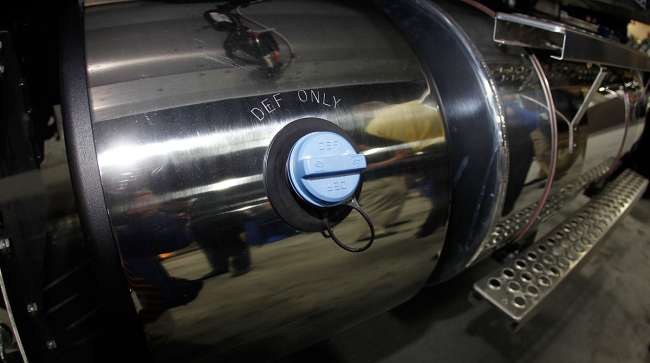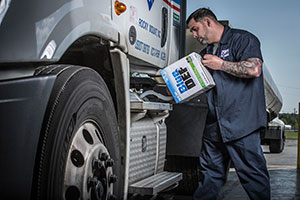Senior Reporter
Failing DEF Sensors Getting Software Fixes From OEMs

[Stay on top of transportation news: Get TTNews in your inbox.]
Software overrides for diesel exhaust fluid sensors that are in perilously short supply are making their way from truck manufacturers to repair shops, helping keep equipment on the road and prevent engine shutdowns that can leave a truck stranded when the sensors fail.
In recent weeks, DEF sensor failures have left thousands of trucks parked, with a scarcity of replacement sensors leaving carriers scrambling for solutions. For some, that meant swapping sensors from trucks that were being retired into trucks that were sitting idle with failed sensors.
There are signs that the arrival of software codes is helping to ease the situation.

Enos
“I have talked to a number of my dealers. They do have the codes and are starting to bring the trucks in to get the code change so they don’t de-rate with the bad sensors,” said Paul Enos, president of the Nevada Trucking Association. “But it’s really ugly right now. I think the truck dealers are having a difficult time with how many trucks they have coming in.”
The software fixes allow engines to operate normally but still require carriers to keep their DEF tanks full, said Marty Makrdichian, service manager at Peterbilt Truck Parts and Equipment in Sparks, Nev.
Makrdichian said when a customer requests a fix, his dealer has to send a message to Peterbilt parent company Paccar, which then decides between a software fix, or, if available, a replacement part.
“People have been waiting for so long for the fixes,” Makrdichian said. “As soon as we get sensors or the software, we pretty much do the work.”
Makrdichian added customers are waiting far shorter than they used to. “It went from being weeks to days,” he said.

A driver fills his tank with diesel exhaust fluid. (Blue DEF)
But Jack Poster, vehicle maintenance reporting standards manager for American Trucking Associations’ Technology and Maintenance Council, said some wait times continue to drag on. “One dealer tech told me he’s had a sensor on order since June,” Poster said.
The software fixes require approval by the U.S. Environmental Protection Agency. Absent that, running a truck with a defective sensor would not only cause its speed to drastically decline, but would violate current federal emissions regulations.
Truck manufacturers have been working collectively through the Truck and Engine Manufacturers Association and individually with EPA and the California Air Resources Board to develop software and calibrations to address the sensor shortage, said Michael Noonan, director of certification and compliance for Navistar Inc.
“Navistar has in fact begun releasing these calibrations to our dealership networks, which is a process that will continue to mature over the next several weeks for the various products we offer,” Noonan said. “We will continue to support products in the field with these calibrations as a form of relief until industry supply stabilizes.”
“We’ve been working on this for a few months,” added Jon Mills, director of external communications for engine maker Cummins Inc. “The parts shortage has been exacerbated by the microchip shortage and made it hard to get the replacement parts. We worked hard to get a temporary calibration fix. We finally got approval on that and have been working with our OEM partners to get those out to the field, and help as many customers as possible. It’s a very collaborative process.”

For some, truck driving is a passion, and the best are America's Road Team Captains. ABF driver Nate McCarty, former America's Road Team Captain, and Elisabeth Barna, COO and executive vice president for American Trucking Associations, join us. Hear a snippet above, and get the full program by going to RoadSigns.TTNews.com.
Mills added, “I believe not all of the OEMs are participating in temporary repair practice, but most are. The ones that are not participating in the TRP have relayed to us that they’re able to get the sensor replacement parts to the customers.”
Despite the improvements in getting the fixes made, concerns exist about future availability of replacement sensors for those used in newer trucks and engine families— from model years 2016-2021 — once those sensors near the end of their service lives, said Glen Kedzie, ATA’s energy and environmental counsel.
Steve Berry, technical staff adviser with the Truck and Engine Manufacturers Association, said repairs to trucks affected by the shortage are returning to the road.
“Manufacturers are working to implement the solutions, with no major issues brought to our attention,” he said.
Want more news? Listen to today's daily briefing below or go here for more info:

